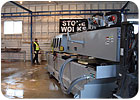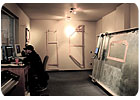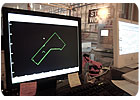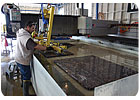
In our small stone shop, our first real purchase was a bridge saw. When we installed it, we simply could not conceptualize a CNC. At that point in our shop history, we could not finance a ham sandwich. Not only could we not finance a CNC machine, sadly enough, we could not even see it down the road. That all changed in a span of only a few years.

Making the digital plunge
Simply put, we made the decision to make the digital plunge because of a huge need - not because of a vision or a plan. We were not visionary; we simply had sore backs. We pulled the trigger on purchasing our CNC. Little did we realize that bringing the CNC into our midst was not only going to increase our profit margins; it would completely redefine our internal definition of what a “shop” actually was. More importantly, it would redefine what our shop could be.When we took delivery of our CNC, I distinctly remember saying to my partner, “This is it. This is the end of the fabrication food chain. We are going to dominate.” We could not see beyond the moment. This was indicative of our management and planning style (or lack thereof). As a matter of fact, I recall saying the exact same thing when we took delivery of our bridge saw, replacing our rail saw.
The shift to the digital method of fabrication actually took place before we took delivery of our machine. Most CNC companies train you for a week at their location before you take delivery, and this was the case with our machine. The manufacturer taught us how to draw and program using CAD/CAM software, how to nest parts on the bed of the machine, troubleshooting, setting up tools, etc. This was an astonishing library of things to remember in one week. At this point in my digital training, I was just learning enough to be dangerous. My nerves were fried, and I felt like I should be getting a first class ticket on a short bus, not a brand new CNC.

The first year of CNC operation
When we first got the machine set up and started pumping out kitchens, every time I hit the “Cycle Start” button, I felt like I was playing Russian Roulette. But in reality, we must not have been that dumb, since we only crashed the machine once and probably smoked only a small handful of parts the first year. The digital trail is not for the faint of heart; it requires a new kind of thinking. It harkens the fall of the craftsman and rise of the technician. Although at first this notion saddens, it saved us in more ways then one. When you invest in a CNC, you actually begin the process of digitizing your company. You do this by default. You have no other option. You are simply compelled. We realized that before we began to run our CNC, we would have to make a decision on how to get the information from the actual cabinets to the CNC. We looked at many options, and we ultimately invested in a digitizing board because we figured that the good old stick template method was the best solution.
The next problem was scheduling. When we added the CNC, we realized we were starting to do more and more work. Scheduling became an issue. We were processing many more parts per day, installing more jobs, managing more employees and slowly losing our minds. Thus, we took another step in becoming a digital shop - digital organization. We purchased a software solution that helps manage scheduling, pricing, inventory, contact management, production and all the nuts and bolts needed to run a stone plant.

The move to a complete digital shop
While we were very happy to surrender the white board we used for scheduling, this was not the case with our stick templates. We plugged away with our CNC, digitizing board and job-tracking software for almost a year before we changed a single thing. Then, one day, digital templating made sense. How could this be? What had changed?Like a weapon of mass fabrication, a new technology was unleashed in the fabrication world - the combination bridge saw/waterjet. It combines the speed of a bridge saw with the details and accuracy of a waterjet. The combination is productive and very powerful. More importantly, it is a 100% digital solution.
We had begun the digital journey with the Web site, followed by the CNC, digitizing board and management software, and now we decided to invest in a combination bridge saw/waterjet. It was a very easy choice, as we were already familiar with the motion controls and software. We were beginning to understand the raw power of digitization. The unit produces parts using the same software as our CNC. Ultimately, I sold the bridge saw and trained our sawyer to be a programmer. We began running two shifts. We started running our CNC and bridge saw/waterjet 18 hours a day without hiring another employee.
The machine payment is the same; they simply run 18 hours instead of eight. Our night shift consists of a programmer and a loader; it is like printing money. The parts that come off the bridge saw/waterjet are perfect. This simple fact allows the CNC to skip the milling step, increasing the speed of the CNC by as much as 25%, depending on the program.
With the bridge saw/waterjet in place, digital templating made more sense then ever. Today, we use a digital templating system with an on-board CAD system and a touch-screen where we simply transfer the DXF file, close the geometries, set the tool path and go.
Again, we were compelled to go with a digital solution, and it completed the transition to a digital shop. With our bridge saw/waterjet and our other digital solutions working together, we have done more work in the last four months then we did in the previous eight months.
I should note that even before our bridge saw and CNC purchases, our company did one very cool digital thing at the very beginning - we had a Web site. We took pictures of every single job we installed, and we now have what may well be one of the biggest stone fabrication Web sites in the world. It was our “sledgehammer” when everything else about our company was small. Web sites matter; get one. (You can check ours out at www.stoneworks.cc)
As technology moves forward, I believe the biggest advances will be in software - imaging, part nesting, inventory control and material handling, to name a few.
Bear in mind, the technology does not simply make you work better (for the most part). I would love to make a checklist and say, “If you do this, this and this, everything will work perfectly.” However, it did not work that way for us, and I assure you, it will not work that way for you. Your individual style and taste matters. What I can tell you is this simple fact that we have learned in the last two years: If there is a digital solution that actually works, it is the best solution.


